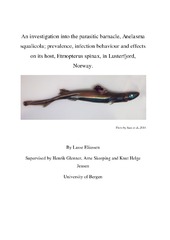An investigation into the parasitic barnacle, Anelasma squalicola; prevalence, infection behaviour and effects on its host, Etmopterus spinax, in Lusterfjord, Norway.
Master thesis
Permanent lenke
https://hdl.handle.net/1956/15831Utgivelsesdato
2016-06-27Metadata
Vis full innførselSamlinger
Sammendrag
Anelasma squalicola is a recently evolved parasite. Very little is known of its biology due to its normally low prevalence in deep sea lantern sharks (family: Etmopteridae), in which it is found embedded in the skin. A population of more heavily infected sharks (Etmopterus spinax) in Lusterfjord, Norway, has allowed for sampling by trawl, and subsequent observations and measurements of the parasite and host. The study shows that E. spinax has a heterogeneous population structure and potentially narrow home range, which likely affects prevalence and dispersal of A. squalicola. A. squalicola appears capable of infecting hosts regardless of size. It has high site specificity, which may be due to areas of the shark where the skin is easier to penetrate. It is most commonly found in pairs, which gives it an atypical intensity distribution. The data suggests the first individual to settle can attract partners to the same site, but this attraction does not result in more infections at other sites on the host. Attracting more than one partner appears to severely reduce their fecundity, which may imply a crowding effect. Infection did not affect liver mass or condition of hosts, but appears to prevent maturation in males. This study provides the most extensive parasitological description of A. squalicola to date, and reveals both a complex host population as well as a highly distinctive infection behaviour, which combined shape this parasite- host interaction.
